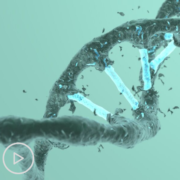Genetic Testing in AML: What Are Doctors Looking For?
Genetic Testing in AML: What Are Doctors Looking For? from Patient Empowerment Network on Vimeo.
Dr. Pinkal Desai, from Weill Cornell Medicine, discusses the genetic testing required in AML, including mutations and changes in chromosomes that are being identified, and how these results can impact risk and prognosis.
Dr. Pinkal Desai is an Assistant Professor of Medicine at Weill Cornell Medical College and Assistant Attending Physician at the New York-Presbyterian Hospital. More about this expert here.
Related Resources

|

|
Transcript:
Dr. Pinkal Desai:
So there are several genes that we look for, but the most important ones from a standpoint of choosing treatments and monitoring, the first one would be FLT3. There are two kinds of FLT3 mutations, ITD and TKD; both can have different drugs that target them.
This is relevant because some of the upfront management, even when we choose – in younger patients, for example, when we are choosing chemotherapy, there are approved FLT3 agents that can be added to the chemotherapy. For example, Midostaurin, that’s a FLT3 inhibitor; we use that, and it’s important to know the FLT3 results, and preferably within 48 hours from the diagnosis, in order to choose the right treatment.
The other mutations that are relevant are IDH1 and IDH2. Both of them have approved targeted treatment against them, so depending on the clinical scenario of the patient, whether it’s new diagnosis or a relapse, these mutations are important to test, and the same for FLT3 as well.
I want to clarify here that sometimes the molecular mutations are absolutely important at diagnosis, but some of these mutations are also important to be retested in people who have relapsed because it’s not always the case that what is present at baseline may be the same at the time of relapse.
It’s possible that the clone is different, so some of these targeted mutations against which we have drugs, like FLT3, IDH, we need to test these mutations at relapse to make sure that we’re not missing them, particularly if they were present at diagnosis. The other mutation that is also relevant is TP53 because there are ongoing clinical trials that are targeting against these mutations, so the relevance of mutations are not only important in approved agents, but also in the ongoing clinical trials that are targeting these mutations.
NPM1 is the other important mutation that is important in risk profiling, as well as monitoring over time to see if we can anticipate relapse or do something about it in the future.
There’s a laundry list of other mutations, but these are – I don’t think that patients should get lost into the individual mutations at the beginning. I think the relevant point here is that all of these need to be sent, and once the panel comes back with all of these mutations, then it’s time to sit down and go through, “Okay, the patient has FLT3, NPM1, plus some other mutation. What does that mean for me?” I think that’s what the patients should be asking. “Okay, I got these three mutations. I have these four mutations. Tell me how this is going to impact my care and my chances of survival?” I think that’s the most important thing.
Everybody’s leukemia is different. It’s more than a mixed bag; it’s actually unique to patients. Someone’s profile and genetic signature is different than someone else’s.
It’s important that every mutation is actually dealt with in relation to the other because it’s not just the presence of individual mutations, but the combinations of all of these mutations that are high relevant in figuring out whether this is important in the future or not.






